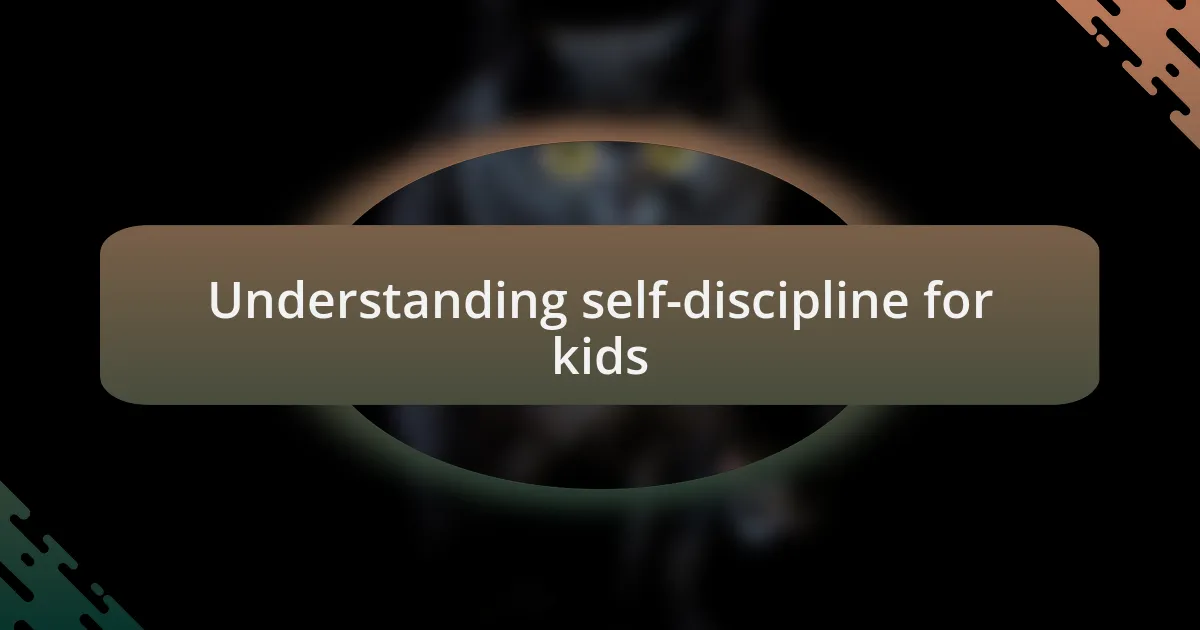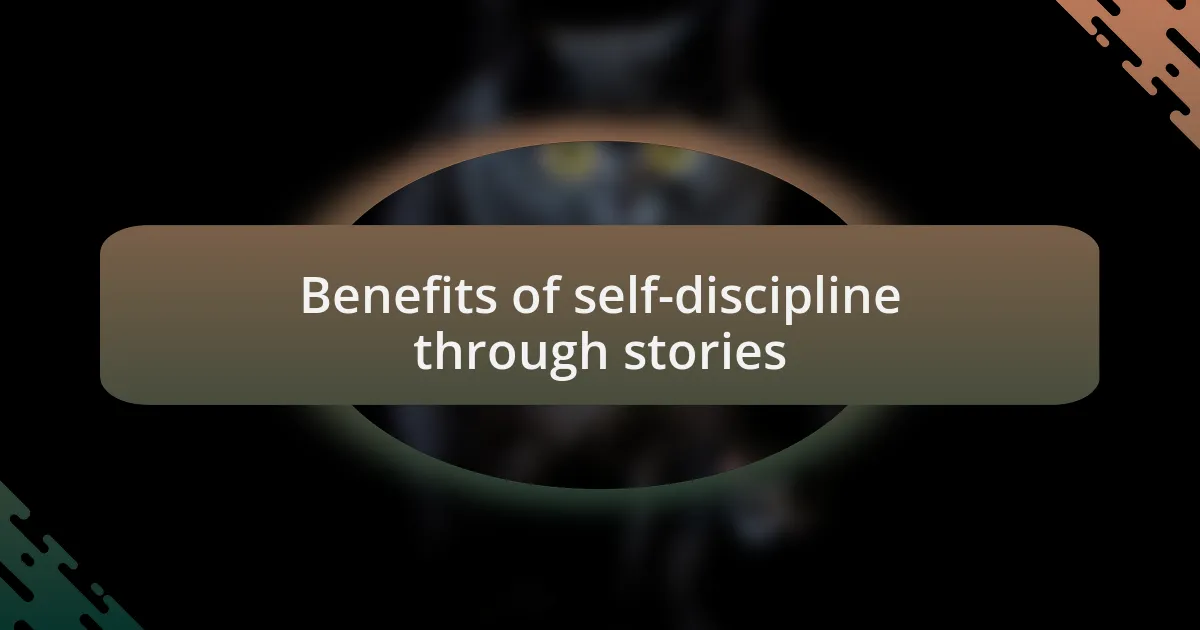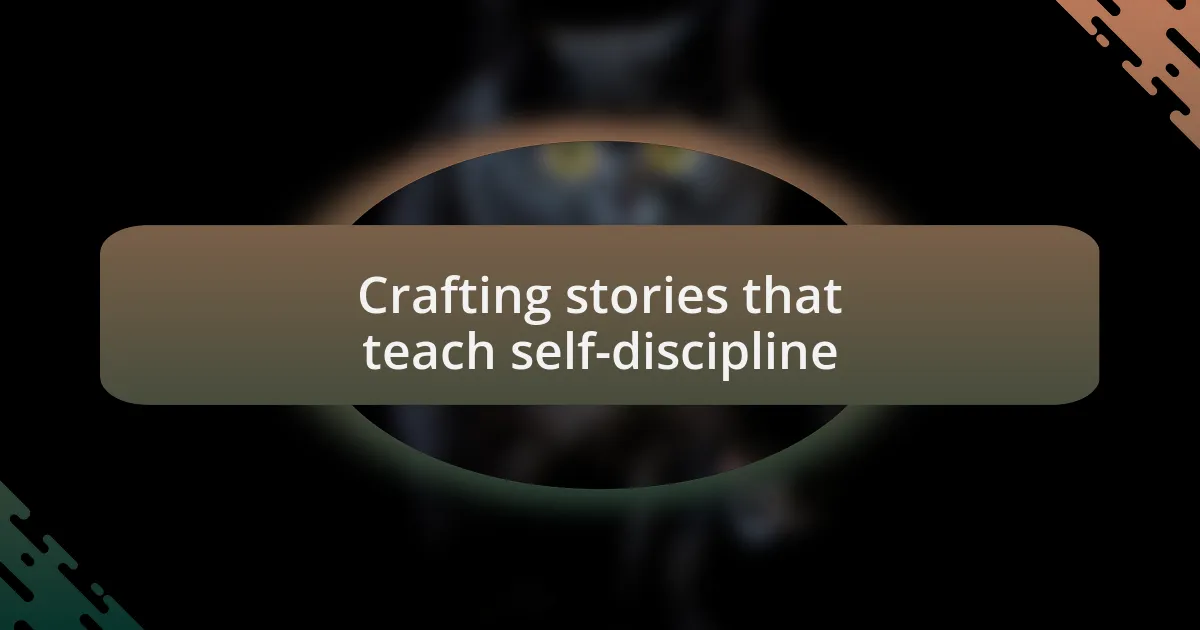Key takeaways:
- Self-discipline is developed through making choices, setting goals, and pushing through discomfort to achieve long-term rewards.
- Stories are effective tools for teaching self-discipline as they spark imagination and provide relatable experiences that resonate with children.
- Crafting engaging narratives about characters overcoming challenges can illustrate the importance of patience, resilience, and personal growth.
- Using humor and personal anecdotes in storytelling can enhance engagement and lead to meaningful discussions about responsibility and discipline.

Understanding self-discipline for kids
Self-discipline is like a muscle; the more you exercise it, the stronger it gets. I remember when I was a child, struggling to complete my homework before jumping into playtime. I often wondered, “Why wait? It’s so much more fun to play now!” But as I grew older, I learned that finishing my work first allowed me to enjoy my playtime without any lingering worries.
Think about the times when you’ve wanted to give up on something challenging, like learning to ride a bike. That initial hesitation is so common! However, when kids push through that discomfort, they discover the satisfaction of mastering a skill. This process isn’t just about the end result; it’s teaching them resilience and the power of delayed gratification.
Developing self-discipline is also about making choices. Personally, I faced countless distractions, but I found that setting small goals helped me stay focused. For instance, I would reward myself with a favorite snack after completing my tasks. In that way, I felt motivated and connected my efforts to a joyful outcome. Isn’t it amazing how small rewards can make a big difference?

Benefits of self-discipline through stories
Stories can be powerful tools for teaching self-discipline. I vividly recall a bedtime story my mother told me about a young boy who dreamed of being a knight. Every night, he practiced hard, even when faced with distractions. This story illustrated the idea that dedication and hard work pay off, reinforcing that self-discipline allows us to achieve our dreams.
In my experience, stories spark imagination and make lessons memorable. I still think about the tale of the tortoise and the hare. While the hare’s brashness led to his downfall, the tortoise taught me the value of steady perseverance. This made me realize that slow but consistent effort is often more reliable than rushing, highlighting how self-discipline can lead to success over time.
Not only do stories entertain, but they also encourage reflection on our own lives. I remember relating deeply to a character who struggled with the temptation to procrastinate. Watching them push through and find their way to success inspired me to tackle my own challenges head-on. How often do we fail to see the direct correlation between engaging narratives and our determination in real life?

Crafting stories that teach self-discipline
Crafting stories that emphasize self-discipline can transform mundane lessons into engaging adventures. I remember creating a story about a young girl who wanted to bake the perfect pie. Each time she was about to give in to her impatience, a wise old owl appeared, reminding her to follow the recipe step by step. This not only made the story enjoyable but illustrated the importance of patience and commitment to achieving her culinary goal.
There’s something magical about stories that teach discipline through relatable challenges. I once shared a tale of a little dragon who wanted to fly but was too scared of heights. With each story, as she faced and accepted her fears, she slowly practiced, and her journey resonated with the kids listening. It sparked discussions about their own fears and how self-discipline can help overcome them. Isn’t it fascinating how characters’ struggles can mirror our own obstacles?
When we craft these narratives, it’s essential to weave in moments of vulnerability and triumph. In a recent story, I portrayed a young boy learning to save his allowance for a special toy. His small sacrifices and the occasional temptation to spend on candy made it relatable for many young listeners. Reflecting on their own choices during these moments could inspire kids to embrace self-discipline in their daily lives. How often do we overlook the power of a simple tale to influence our mindset?

Engaging children with personal stories
When I think about engaging children with personal stories, I recall an experience where I shared a story about a mischievous cat trying to sneak into the cookie jar. The cat faced numerous distractions, but each time it was about to give in, it remembered how happy it felt when it finally earned a treat. This moment not only entertained the kids but sparked laughter and illustrated the concept of self-control in a light-hearted way.
Sharing stories that resonate personally can create a profound connection with young listeners; I once recounted a time I struggled to complete a challenging puzzle. As I described my frustration and the eventual joy when I finally finished, I noticed the kids nodding in agreement. They saw themselves in my journey and began to open up about their own experiences, making the storytelling session more interactive. Isn’t it remarkable how a shared struggle can turn into a lesson about persistence?
I’ve also found that using humor in storytelling can greatly enhance engagement. One time, I told a story about a kid who kept forgetting to do his chores; each time, a hilarious situation unfolded. The kids loved the antics and, through laughter, began to discuss how small distractions can lead to bigger consequences. It’s interesting how these lighter moments can lay the groundwork for deeper conversations about responsibility and self-discipline. How can we make everyday lessons as captivating as a good laugh?

Using storytelling to reinforce lessons
Stories can serve as powerful tools for reinforcing lessons, especially when they reflect real-life scenarios. I remember sharing a tale about my attempt to learn a new skill, like riding a bike. I vividly described the initial falls and the frustration I felt, but just when I was about to give up, the thrill of riding smoothly for the first time kept me going. Kids related to my triumphs and struggles, realizing that persistence is key, no matter the challenge.
One evening, while recounting a story about a boy who learned to manage his time after missing a fun event due to procrastination, I could see the wheels turning in the minds of my young listeners. They empathized with his regret and began sharing their experiences with similar situations. It was a beautiful moment; they started reflecting on their habits and how timing plays a critical role in achieving their goals. How often do we overlook the importance of our choices in the moment?
Additionally, using relatable characters who face obstacles can help kids visualize complex lessons. In a story about a resilient little tree that refused to give in to a harsh storm, I emphasized how it bent but didn’t break. As I narrated the tree’s journey to stand tall again, I noticed the children’s eyes light up in understanding and hope. Can a simple story about nature teach us about resilience and growth? I believe it can; storytelling taps into emotions and helps reinforce vital lessons in a way that is both accessible and memorable.